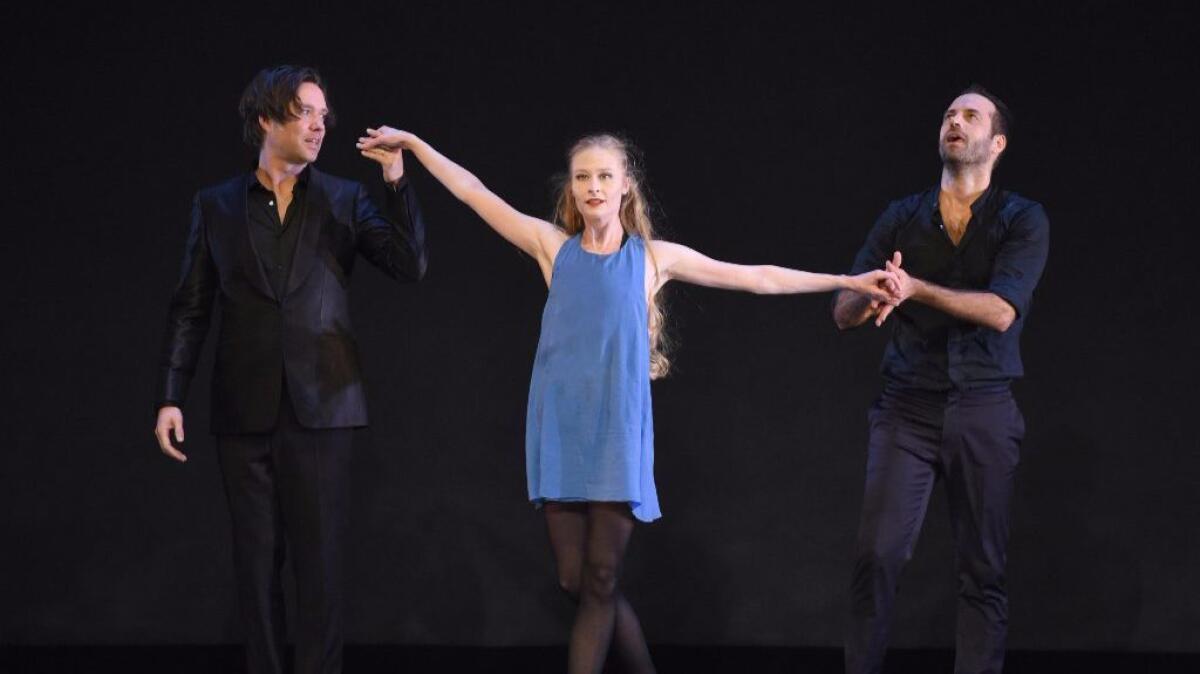Review: Benjamin Millepied performs in a beautiful premiere for L.A. Dance Project

When Benjamin Millepied launched L.A. Dance Project four years ago, he intended it to be a primary home for his choreography, not a place where he would be the star dancer.
Fair enough; he had just retired as a longtime principal dancer with New York City Ballet. Let’s face it, though, some of us have been hoping to see a little more of Millepied the dancer. By my count, he’s performed locally just once, when he traipsed through the galleries at the Museum of Contemporary Art in the summer of 2012, with an overflow crowd following him.
The latest LADP concert at the Ace Hotel’s theater this past weekend was a partial reward for patience. He’s back from that sideline of running the Paris Opera Ballet and was back onstage in the premiere of “Homecoming,” with another retired New York City Ballet principal dancer, and chum, Janie Taylor.
It was friends and guest artists who provided the highlights on this four-dance program, seen Saturday. Millepied’s move here has been partly responsible for an influx of other high-profile dancers to Los Angeles, and they have established roots not just at LADP, but at the Colburn School too. There is Taylor, who officially joins the company roster in January and additionally is a costume designer. And there is Carla Körbes (LADP’s associate director), a dancer of luscious amplitude, who appeared on the program with Pacific Northwest Ballet principal Batkhurel Bold in Christopher Wheeldon’s “After the Rain.”
Songsmith Rufus Wainwright was “Homecoming’s” other guest star, and he stirringly sang and played piano for his own compositions, “Sonnet 20,” “Sonnet 43” and “Zebulon.” His plaintive voice added poignancy to the achingly heartfelt duet Millepied fashioned for himself and Taylor.
Closely mirroring the undercurrents of Shakespeare’s poetry and Wainwright’s lyrics, Millepied has the duo pinned together, first swirling and swooping, side by side and nearly always attached. Millepied next explores the crushing, disorienting blow of lost affections, as first he, then Taylor, portrayed lovers lost, blinded nearly. In repeated dance phrases, they reached out, searching for their beloved, coming up empty-handed. Eventually, they reunite, with joy but also sorrow.
Taylor is an accomplished and detailed ballerina, and well expressed the euphoria and darkness within the piece. At 39, Millepied still performs with effortless élan. His jumps go higher and his turns revolve faster than seems possible, given the lack of buildup he needs or shows, and his almost laissez-faire demeanor. This attitude is one of the stylistic attributes of his choreography overall, and it doesn’t always translate onto other performers, even though the L.A. Dance Project dancers are aces. Here, though, it made for a beautiful premiere.
Millepied’s other choreographic effort of the night, “On the Other Side,” was less alluring, though it does have a stunningly exquisite, multicolored backdrop by Los Angeles artist Mark Bradford. In nine sections, it is danced to differing compositions by Philip Glass (played by pianist Richard Valitutto), and is a continually flowing rush of breathless runs, skips and circles. The dancers, clad in single-colored, loose-fitted pants and tops or dresses (costumes by Alessandro Sartori), shot about the stage with the fevered energy of Bradford’s colorful mosaic behind them, like swatches given life.
The nonstop pulse becomes mind-numbing, though. Millepied suggests relationships among the dancers, but fully commits himself only once, in a gorgeous male duet for Morgan Lugo and Robbie Moore. In another section, Lilja Rúriksdóttir was outstanding as a woman alone, perhaps seeking connections, but turned away by others.
The evening’s other local debut was “II Acts for the Blind,” a somewhat humorous and jaunty dance-theater piece by Israeli choreographer Roy Assaf. Full of jagged stops and starts and repetitive gestures, “II Acts” is done twice — once in quiet with the dancers wearing beige and a second time while wearing street clothes (Taylor did the costumes). The second time through, an animated Rachelle Rafailedes narrates every move.
Assaf exacts a transformation in what the audience “sees” by first having “naked” dancers and then by dressing them up. The verbal suggestions suddenly give new meanings to previously innocuous gestures, such as when Julia Eichten’s walk across the stage becomes “sauntering,” and Lugo’s pumping legs turn into a vertical bicycle ride.
Choreographer Wheeldon’s “After the Rain” was slipped in between Assaf’s and Millepied’s premieres and felt like a cleansing sorbet. At just under 10 minutes long, the duet has become a popular gala offering. It is so pure it reverberates long after it’s over. This is due to the starkness of the music, Arvo Pärt’s “Spiegel Im Spiegel,” which was performed with exquisite finesse by Colburn student musicians Qiele Guo and Albert Cano Smit.
But it’s also the simplicity and deliberateness of the steps. Every gesture communicates, and that’s one of the beauties of Körbes’ dancing—she inscribes the space with her feet, hands, her whole body. Bold was a sympathetic partner, bravely facing the loss this duet suggests.
Kudos to the other LADP dancers not previously mentioned: Stephanie Amurao, Aaron Carr, David Adrian Freeland Jr. and Nathan Makolandra. Finally, will this be the last time we see Millepied onstage in ballet slippers? He says it will be, might be, but here’s hoping it’s not.
SIGN UP for the free Essential Arts & Culture newsletter »
Follow The Times’ arts team @culturemonster.
ALSO
Times art critic Christopher Knight’s latest reviews
Times theater critic Charles McNulty’s latest reviews
Times architecture critic Christopher Hawthorne’s latest columns
Times music critic Mark Swed’s latest review
More to Read
The biggest entertainment stories
Get our big stories about Hollywood, film, television, music, arts, culture and more right in your inbox as soon as they publish.
You may occasionally receive promotional content from the Los Angeles Times.










